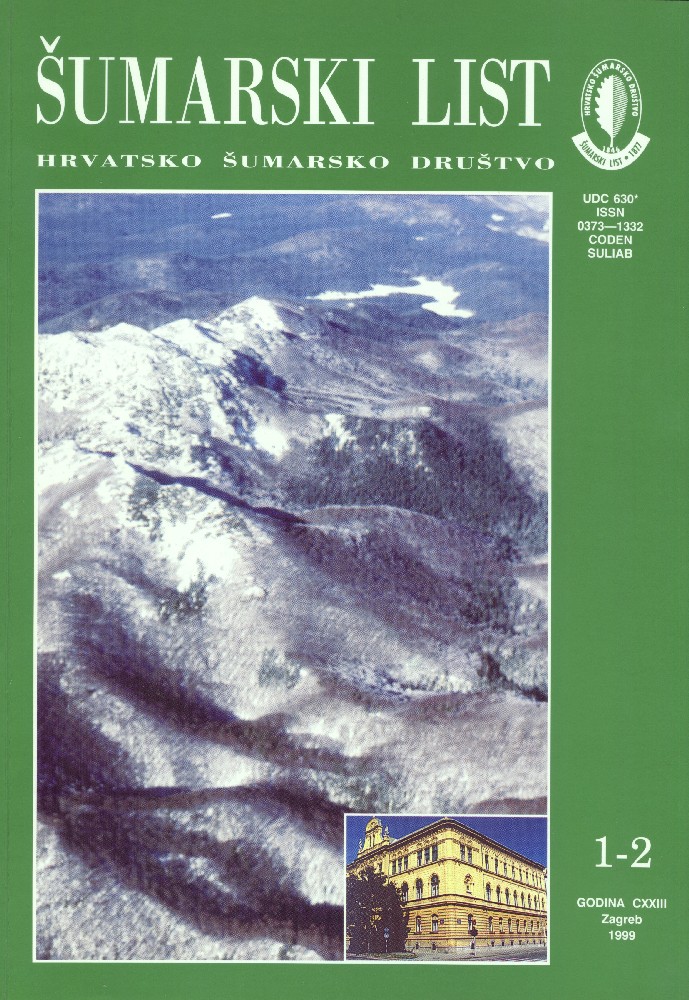
broj: 1-2/1999
pdf (21,0 MB) |
|
||||||||||||||
| IZVORNI ZNANSTVENI ČLANCI | ||
| Kajba, D., Bogdan, S. | UDK 630* 165. 001. | |
| Estimate of genetic parameters in black poplar clonal tests (Section Aigeiros) pdf HR EN | 3 | |
| Trinajstić, I. | UDK 630* 169 + 189. 001. | |
| What are Abies pardei Gussone and "Abies biokovoensis"? pdf HR EN | 11 | |
| Baričević, D. | UDK 630* 181.9 + 182.9 001. | |
| Ecological and Vegetative Changes in Penduculate Oak Forests in the Management Unit "Žutica" pdf HR EN | 17 | |
| Lukić, N. | UDK 630* 585 + 11 : 181.9. 001. | |
| Dendroclimatological analysis of common beech (Fagus sylvatica L.) on Papuk pdf HR EN | 29 | |
| STRUČNI ČLANCI | ||
| Domac, J. | UDK 630* 839.9 + 620.91 | |
| Use of forestry biomass for energy in Finland pdf HR EN | 37 | |
| Summary: Finland is a leading country in the use of bioenergy and has excellent opportunities for increasing bioenergy use from the level of 20% of today up to 25-30%. The Finnish Government has set as an objective for the promotion of bioenergy a 25% increase from the present level by 2005. This increment corresponds to 1.5 million tonnes of oil equivalent (toe) per year R&D work has been considered to be the most important means to achieve this ambitious goal. The aim of the Finnish Bioenergy research programme for the years 19931998 is to increase the use of economically profitable and environmentally sound bioenergy by improving the competitiveness of solid biofuels. The main research fields concern production methods of wood fuels, use of bioenergy, and conversion of biomass to bio-oils. This paper concentrates on wood fuels and forestry biomass production research. Finnish forests contain substantial biomass reserves. The most important resources of energy wood are trees removed during the precommercial and early commercial thinning of young stands, residual stemwood and crown mass from regeneration cuttings and poor quality, small-sized deciduous trees from under-productive stands. The main utilisation of wood-based fuels is in the forest industry, which uses a substantial amount of wood raw material for the production of energy. The volume share of energy raw material is 15-25%) for the saw-milling industry, 40-50%>for the plywood/veneer industry, 10-15% in the mechanical pulp industry and 50-60%) in the sulphate pulp industry of all raw material, bark included. In all cases, the fuel component is processed from industrial residue, so that the use of wood-based fuels in the forest industry is essentially passive. Great emphasis has been placed on wood-fired heating and cogeneration plants in the prevailing discussion on the use of wood-based fuels. Today share of biomass in electricity generation is more than 10%. Data presented in paper were collected and photos taken during authors visit Finland in September 1998 as a participant of IE A Bioenergy International Workshop. Additional informations were collected from Prof Dr. Pentti Hakkila (Finnish Forest Research Institute), Prof. Dr. Kai Sipila (VTT Energy), Dr. Ilka Savolainen (IVO Group) and Mr. Arto Heikkinen (IVO Group). For Croatia is in some points similar to Finland (history, population, significant forest areas) Finnish experiences and bright example of bioenergy use could be interesting and useful. This paper gives a brief historical overview of bioenergy use and state of the art today in Finland, main characteristics of Bioenergia programme and current trends of bioenergy use, some information about bioenergy market and electricity generation from biomass in Finland and short description of the Biowatty Oy, a national producer and marketer of bioenergy. Key words: Finland; bioenergy; forestry biomass | ||


